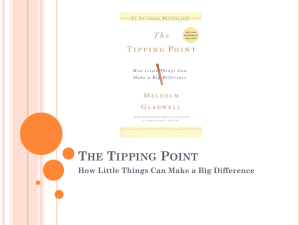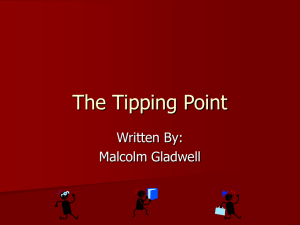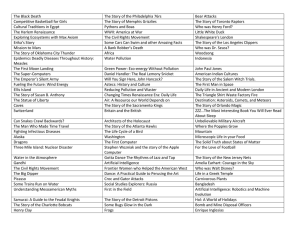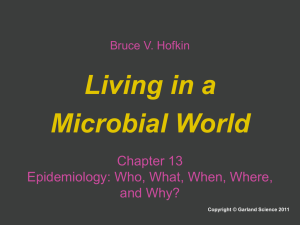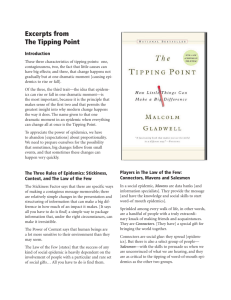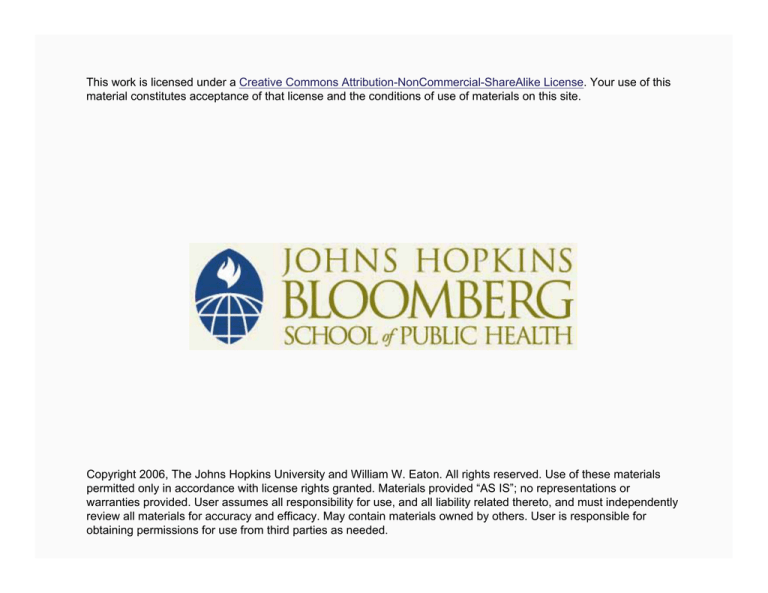
This work is licensed under a Creative Commons Attribution-NonCommercial-ShareAlike License. Your use of this
material constitutes acceptance of that license and the conditions of use of materials on this site.
Copyright 2006, The Johns Hopkins University and William W. Eaton. All rights reserved. Use of these materials
permitted only in accordance with license rights granted. Materials provided “AS IS”; no representations or
warranties provided. User assumes all responsibility for use, and all liability related thereto, and must independently
review all materials for accuracy and efficacy. May contain materials owned by others. User is responsible for
obtaining permissions for use from third parties as needed.
Somatoform Epidemics
as Emergent Collective Behavior
William W. Eaton, PhD
Johns Hopkins University
Section A
Historical Examples and Outline
Breughel, Dance at Molenbeek, 1564
4
Hondius, Woodcut of Breughel’s Drawing
Continued
5
Hondius, Woodcut of Breughel’s Drawing
6
Brouillet, Clinical Lecture at the Salpetriere
7
Social Transmission and Collective Behavior
Transmission—reproduction of a behavior after
social interaction
Collective behavior—coordinated interaction not
based on pre-existing norms, roles, or institutions
Examples—riots, panics, fads, social movements
Continued
8
Social Transmission and Collective Behavior
Transmission—reproduction of a behavior after
social interaction
Collective behavior—coordinated interaction not
based on pre-existing norms, roles, or institutions
Examples—riots, panics, fads, social movements
Social theories for collective behavior
− Strain
− Contagion
− Structure
− Emergent norm
Continued
9
Social Transmission and Collective Behavior
Transmission—reproduction of a behavior after
social interaction
Collective behavior—coordinated interaction not
based on pre-existing norms, roles, or institutions
Examples—riots, panics, fads, social movements
Social theories for collective behavior
− Strain
− Contagion
− Structure
− Emergent norm
The somatic reservoir of non-specific complaints
and behaviors
10
Social Transmission of Bizarre Behaviors
Short term epidemics
− Dancing manias
− Fainting
− Ideas—windshield pitting
− Fear—harbor city
− Somatic complaints—June bug
− Review of 140 epidemics
− Recent examples—Coca Cola, itching
Continued
11
Social Transmission of Bizarre Behaviors
Group-based mechanisms—influence
− Autokinetic effect
− Group conformity
− Perception of unanimity
RESCITE model
Continued
12
Social Transmission of Bizarre Behaviors
Chronic epidemics
− Chronic fatigue
X Germs or beliefs?
− Gulf War
X Indiana outbreak
X Questionnaire and responses
X Onset
X CCEP
− Other possible examples
X Multiple chemical sensitivities
X Sick building syndrome
Group effects—attribution theory
− Fundamental attribution error
− Self attribution
− Insufficient justification
RESCITE model
13
Section B
Three Exemplar Epidemics: Windshield Pitting;
Harbor City; June Bug
Seattle Windshield Pitting Epidemic
Newspaper Coverage
300
Column Inches
250
+
+
200
150
+
100
+
50
+
13
14 Ap
r
15 Ap
r
16 Ap
r
17 Ap
r
18 Ap
r
19 Ap
r
20 Ap
21 A r
p
Ap r
pr
r
Ap
ar
M
6
28
M
ar
ar
M
25
23
M
ar
+
++
+
+
30
0+
Date of Newspaper Report
Source: Adapted from Medalia and Larson (1958)
15
Beliefs about Windshield Pitting
Unsure
Ordinary road wear
Atomic test
Vandalism
Industrial air pollution
Hysterical beliefs
Meteor dust
Cosmic rays
Sand fleas
16
How Many Actually Observed Windshield Pitting?
Percent who actually observed windshield pitting
damage
− Males—8%
− Females—3%
17
Why Did the Epidemic Die Out?
Interest versus belief
Atomic cloud as transient cause
“Acute outbursts of mass delusion are not
necessarily self-limiting. Interest and belief in a
phenomenon for which no scientific basis can be
found may well persist for periods of time even in a
culture presumably committed to science as the
ultimate test of reality.”
Source: Medalia and Larson, ASR, 1958
18
Harbor City School Epidemic
Headache—57%
Nausea—52%
Dizziness—51%
Abdominal pain—51%
Other < 30%
Continued
19
Harbor City School Epidemic
Headache—57%
Nausea—52%
Dizziness—51%
Abdominal pain—51%
Other < 30%
Any = Transmission completion rate—77%
20
News Reports about the June Bug
Wednesday 6 pm—officials at Montana Mills shut
down their Strongsville plant this afternoon
because of a mysterious sickness. . . severe nausea
and a breaking out over the body. . . . Some kind of
insect . . .
Wednesday 11 PM—200 employees . . . apparently
an insect . . .
Thursday—the mill opened after a night of
debugging . . . diagnosis is still hanging fire . . .
Friday—two experts from the U.S. Communicable
Disease Center . . . searched the plant . . .
Continued
21
News Reports about the June Bug
Saturday—among the specimens was a small
chigger-like bug. . . . The press has played the
“mystery malady angle too much. . . .” State Health
official—“we don’t question that some of these
people have been bitten . . .”
Sunday—nervous disorder, publicity, and lastly, a
bug’s bite caused the outbreak of a “very real”
sickness
Monday—business is back to normal . . . as one
exterminator put it—“what has been here ain’t here
now.”
22
Evidence of Strain among Cases in the June Bug Epidemic
Cases were more likely to . . .
− Be working overtime
− Avoid their supervisors
− Notice variation in output between individuals
− Be the major breadwinner in the family
− Have small children
23
June Bug Epidemic Friendship Status by Time
Friendship
Status of Cases
Period of Occurrence for Cases
Percentages (n)
Takeoff
Period
Day 1
Day 2
Resolution
Period
Isolated
(n = 56 cases)
83 (6)
21 (24)
23 (22)
25 (4)
Choosing Cases
(n = 83 choices)
46 (11)
61 (41)
54 (28)
33 (3)
Chosen by Cases
(n = 78 choices)
0 (2)
61 (41)
67 (30)
20 (5)
Source: Data from Kerckhoff and Back, The June Bug, 1968
24
Review of 140 Short-Term Emotional, Delusional,
or Somatoform Epidemics, 1872-1993
N um ber of
E p id e m ic s
P e rc e n t
L o ca tio n
School
T o w n o r V illa g e
F a cto ry
H o sp ita l o r In stitu tio n
O th e r
69
24
28
10
9
49
17
20
7
6
N u m b e r o f P e o p le Ill
< 1 0 P e o p le
1 0 -3 0 P e o p le
> 3 0 P e o p le
U n kn o w n
29
38
63
7
21
27
45
5
G e n d e r o f Ill P e o p le
A ll F e m a le
M a le s a n d F e m a le s
A ll M a le s
U n kn o w n
68
60
4
7
48
43
3
5
A g e o f Ill P e o p le
< 20
2 0 -4 0
A ll A g e s
U n kn o w n
65
17
28
29
46
43
3
5
D u ra tio n
< 3 D ays
3 -1 4 D a y s
1 5 -3 0 D a y s
> 30 D ays
U n kn o w n
30
45
16
28
21
21
32
11
20
15
Source: Data from Eaton, Sociology of Mental Disorders, 2001.
25
Section C
Experimental Data on Group Influence
Sherif—Autokinetic Effect
1. Enter the classroom
2. Very, very dark
3. A light appears
How far did the light move?
27
Social Influence on Formation of a Norm: How far did the light move?
28
Social Influence on Formation of a Norm: How far did the light move?
29
Asch Group Conformity Experiment
30
Theoretical Summary So Far
From Sociology
− Strain
X External problem
X Event leader
− Contagion
X Imitation/
suggestion
− Structure
X Schools!
− Emergent norm
From Social Psychology
Continued
31
Theoretical Summary So Far
From Sociology
− Strain
X External problem
X Event leader
− Contagion
X Imitation/
suggestion
− Structure
X Schools!
− Emergent norm
From Social Psychology
− Definition of group
− Autokinetic effect and
creation of a norm
− Influence of strong
majority
− Perception of strong
majority
32
Section D
The RESCITE Model
The Problem of Directing Behavior
Situation of
Everyday Life
Problematic
Situation
High
Expected
Probability
of a Given
Response
Low
A B C D E
Possible Responses
A B C D E
Possible Responses
34
Rescite Model
Responsive Emotional Schemata
Convergence of Models and susceptibles
Initiation of Problem Solving
Transmission to susceptibles
(Resolution or)
Endurance
35
RESCITE Model of Somatoform Epidemics
Convergence 4/15
Models
Early
Susceptibles
Late
Susceptibles
Arrow = individual behavior
Red Arrow = individual behavior is the RES
Continued
36
RESCITE Model of Somatoform Epidemics
Models
Early
Susceptibles
Late
Susceptibles
Convergence
4/15
Initiation
6/15
Continued
37
RESCITE Model of Somatoform Epidemics
Models
Early
Susceptibles
Late
Susceptibles
Convergence
4/15
Initiation
6/15
Transmission
9/15
Continued
38
RESCITE Model of Somatoform Epidemics
Models
Early
Susceptibles
Late
Susceptibles
Convergence
4/15
Initiation
6/15
Transmission
9/15
Resolution
4/15
Continued
39
How to Stop an Epidemic
Dismember the group
− Behavioral
− Mental
Generate a counter-norm
40
Acute Epidemics—Summary
Somatoform epidemics are rare but regular
Somatoform epidemics often involve young women
Populations are heterogeneous, consisting of
models and reactive susceptibles
The social structure of the epidemic evolves
The behavior or complaint is non-specific and
subjective
Only a small proportion actively demonstrate the
target behavior or complaint
The science of group behavior is relevant
Usually the epidemics are self-limiting
41
Section E
Examples of Chronic Epidemics
Defining Chronic Fatigue Syndrome
Defining Chronic Fatigue Syndrome
For various reasons, including overwork, insufficient rest, and the presence of physical
illness, millions of people suffer from chronic fatigue, but only a minority of these have
what has come to be called chronic fatigue syndrome. To aid physicians at arriving at
a diagnosis of C.F.S., in 1994 the United States Centers for Disease Control and
Prevention outlined these criteria:
Severe unexplained fatigue for over six months that is:
•Of a new or definite onset.
•Not due to continuing exertion.
•Not resolved by rest.
•Functionally impairing.
And the presence of four or more of the following new symptoms:
•Impaired memory or concentration.
•Sore throat.
•Tender lymph nodes.
•Pain in several joints.
•New pattern of headaches.
•Unrefreshing sleep.
•Post-exertional malaise lasting more than 24 hours.
Source: The CDC
43
Chronic Fatigue—Early Examples
Fatigue as most subjective of symptoms
19th–20th century—nervous exhaustion, soldier’s
heart, neurasthenia
Myalgic encephalitis (ME) and polio as symbolic
template
Epidemics in Los Angeles, U.K., South Africa,
Malaysia, etc.
Absence of ME epidemics in U.S. for 20 years
44
Chronic Fatigue—Recent History
Lake Tahoe as the “seed” epidemic
New interest in immune system in medicine
Interest from Congress
CDC as verifier of disease status
45
Selected Symptoms of the Chronic Fatigue Syndrome
ECA 13,538 Respondents at Four Sites
Lifetime Prevalence in Percent
Symptom
Persistent Fatigue
Not Explained by Illness or Drugs
Which Disrupts Normal Activities
General Muscle Weakness
Muscle Discomfort
Headache
Joint Pain
Sleep Problems
Source: Data from Price et al, PHR, 1992
Prevalence (%)
23.7
13.9
2.6
8.7
18.0
20.5
29.2
25.6
46
What Predicts Chronicity of Fatigue?
Despite extensive research, no germs are connected
to chronic fatigue
Despite extensive research, no genes are connected
to chronic fatigue
Despite extensive research, no kinesiologic
characteristics connected to chronic fatigue
Repeated findings of belief in a physical cause
predicting chronicity of fatigue
Caution—in individuals, fatigue is caused by many
things!
47
Why Doesn’t the Epidemic Stop?
Dismembering the group?
− CFIDS Association, ME Associations
− CFIDS Honor Roll of Physicians
− Psychiatrists as the enemy
Source: Strauss, Br Med J., 1996
Continued
48
Why Doesn’t the Epidemic Stop?
Developing a counter norm?
− “It will prove difficult to totally dispense with
this [immune function] model because negative
studies are never viewed as conclusive, because
periodically we discover new candidate
microbes, and because technology affords ever
more sensitive means of detecting and studying
them, but the concept will languish for lack of
rigorous support, as have so many other earlier
models of chronic fatigue”
49
Indiana 123rd ARCOM as the Seed Epidemic
Continued
50
Indiana 123rd ARCOM as the Seed Epidemic
Continued
51
Indiana 123rd ARCOM as the Seed Epidemic
52
Symptoms Reported by Reservists of 123rd ARCOM
Fatigue (in percent)
70.9
Sleep disturbance
57.0
Forgetfulness
54.4
Pain in any joint
54.4
Dental complaint
47.4
Easily irritated
46.8
Difficulty concentrating
43.0
Depression
41.8
Difficulty thinking
39.2
Headache
37.2
Rash
35.4
Cough
34.6
Abdominal pain
34.2
Joint pain in upper extremity
32.9
Diarrhea
32.1
Joint pain in lower extremity
30.4
Pain in back of neck
26.9
Ringing or pain in ear
24.1
Loss of hair
21.5
Fever
12.8
Source: Data from DeFraites et al, 1992
n = 79
53
Onset of Fatigue by Calendar Month
123rd Army Reserve Command
12
Number of Persons
10
8
6
4
2
0
1
2
3
4
5
6
1991
Source: redrawn from DeFraites et al, 1992
7
8
9
10 11 12
1
2
3
1992
54
Onset of Fatigue by Months since Return
123rd Army Reserve Command
Number of persons
14
12
10
8
6
4
2
0
-6 -5 -4 -3 -2 -1 0 1 2 3 4 5 6 7
Months since Redeployment
Source: redrawn from DeFraites et al, 1992
8
9 10
55
Lieutenant General Dale Vesser* on Gulf War Illnesses—1997
“…The Gulf War illnesses are especially frustrating
because we lack answers for basic questions. So
many of our troops have been struck down, not by
the enemy on the field of combat, but by something
we don’t understand. They ask ‘what have I got and
how did I get it?’ They deserve answers. But we
haven’t provided them. I hope I’ll be able to find
some of those answers.”
* Deputy Special Assistant Secretary of Defense
Source: Gulflink, 1997: http://www.dtic.mil:80/gulflink/news.
56
The Gulf War “Syndrome” in British Soldiers
Prevalence of Symptoms
60
Gulf
Bosnia
Era
50
40
30
20
10
0
Most Frequent
Least Frequent
Source: Data from Simon Wessely, presentation at American Psychopathological Association Conference,
March 2004, New York City.
57
Section F
Attribution Theory
The Fundamental Attribution Error
59
Self Attribution
60
Insufficient Justification Effect
Continued
61
RESCITE Model of Somatoform Epidemics
Models
Early
Susceptibles
Late
Susceptibles
Convergence
4/15
Initiation
6/15
Transmission
9/15
Endurance
7/15
Continued
62
Chronic Somatoform Epidemics—Summary
Chronic epidemics may endure for decades
Seed epidemics may resemble acute somatoform
epidemics
Chronic epidemics are more likely to involve adults
Beliefs about cause and about the self may be
central to understanding the epidemics
Attacking the group may be counterproductive
63

